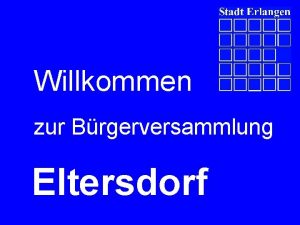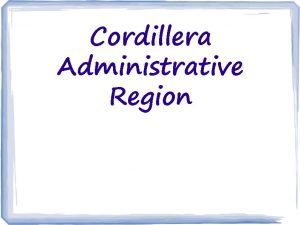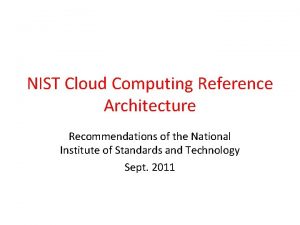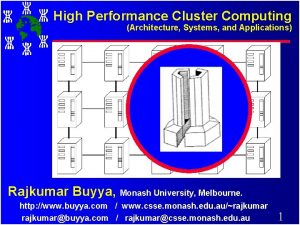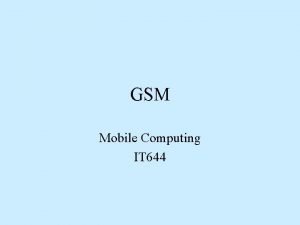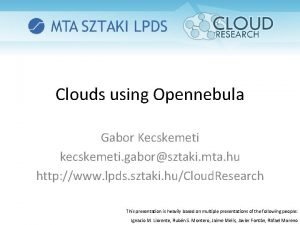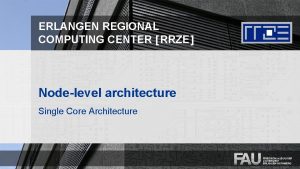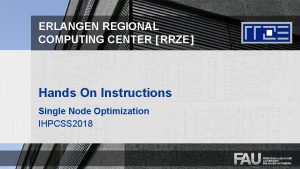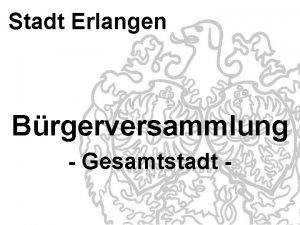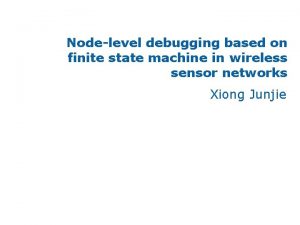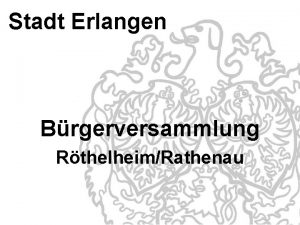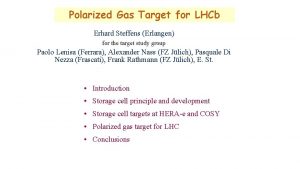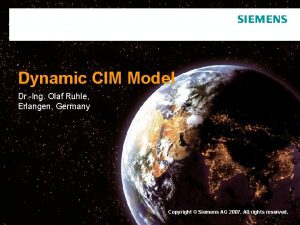ERLANGEN REGIONAL COMPUTING CENTER RRZE Nodelevel architecture Memory
![ERLANGEN REGIONAL COMPUTING CENTER [ RRZE ] Node-level architecture Memory hierarchy ERLANGEN REGIONAL COMPUTING CENTER [ RRZE ] Node-level architecture Memory hierarchy](https://slidetodoc.com/presentation_image_h2/f1ebd7cb53142a653fa3a4efa31d1f2e/image-1.jpg)
































- Slides: 33
![ERLANGEN REGIONAL COMPUTING CENTER RRZE Nodelevel architecture Memory hierarchy ERLANGEN REGIONAL COMPUTING CENTER [ RRZE ] Node-level architecture Memory hierarchy](https://slidetodoc.com/presentation_image_h2/f1ebd7cb53142a653fa3a4efa31d1f2e/image-1.jpg)
ERLANGEN REGIONAL COMPUTING CENTER [ RRZE ] Node-level architecture Memory hierarchy

Von Neumann bottleneck reloaded DRAM gap Approx. 10 F/B Main memory access speed not sufficient to keep CPU busy… Introduce fast on-chip caches, holding copies of recently used data items 2

Schematic view of modern memory hierarchy & cache logic § CPU/Arithmetic unit issues a LOAD request to transfer a data item to a register § Cache logic automatically checks all cache levels if data item is already in cache. § If data item is in cache (“cache hit”) it is loaded to register. § If data item is in no cache level (“cache miss”) data item is loaded from main memory and a copy is held in cache. § 3

Memory hierarchies Effective Bandwidths Hardware: Quantities to characterize the quality of a memory hierarchy: § § Latency (Tl): Set up time for data transfer from source (e. g. main memory or caches) to destination (e. g. registers). § Bandwidth (b): Maximum amount of data per second which can be transferred between source (e. g. main memory or caches) and destination (e. g. registers). 4

NODE-LEVEL ARCHITECTURE Caches – Basics

Memory hierarchies The latency problem § Main memory latency and bandwidth for modern multicore CPUs: Tl = 64 ns & b = 64 GB/s V 8 B 128 B 4096 B Tl 64 ns V/b 0. 125 ns 2 ns 64 ns T 64. 125 ns 66 ns 128 ns beff 0. 13 GB/s 1. 9 GB/s 32 GB/s Data access is organized in cache lines (CL) – always a full CL is transferred Multiple CLs can be loaded concurrently V=64 B or V=128 B on Multiple data requests by application code modern architectures Automatic hardware prefetching 6

Memory hierarchies Cache lines § If one data item is loaded from main memory (“cache miss”), whole cache line it belongs to is loaded § Cache lines are contiguous in main memory, i. e. “neighboring“ items can then be used from cache Iteratio t n 1 2 LD Cache miss : Tl LD 4 5 Use data LD 3 do i=1, n s = s + a(i)*a(i) enddo Use data Cache line size: 4 words Use data LD Use data 6 7 8 LD Use data LD Use 7

Memory hierarchies (Automatic) Prefetching § Prefetching data to hide memory latencies of CL transfers Iteration 1 2 LD Cache miss : Tl do i=1, n s = s + a(i)*a(i) enddo Use data LD 5 Use data LD 6 8 Use data LD 4 7 Use data LD 3 t LD Data transfer is started before cache miss Prefetching Use data LD LD Use data LD Use 8

Memory Hierarchies Prefetching – Hide memory latency § Prefetch (PFT) instructions (limited use on modern architectures): Transfer one cache line from memory to cache and then issue LD to registers § Most architectures (Intel/AMD x 86, IBM Power) use hardware-based automatic prefetch mechanisms § HW detects regular, consecutive memory access patterns (streams) and prefetches at will § Intel x 86: Adjacent cache line prefetch loads 2 (64 -byte) cache lines on L 3 miss Effectively doubles line length on loads (typical. enabled in BIOS) § Intel x 86: Hardware prefetcher: Prefetches complete page (4 KB) if 2 successive CLs in this page are accessed § For regular data access main memory latency is not an issue! § May generate excessive data transfers for irregular access pattern 9

NODE-LEVEL ARCHITECTURE Data access locality

Memory Hierarchies Cache line Spatial locality § Cache line features § Cache line use is optimal for contiguous access (“stride 1”) STREAMING § Non-consecutive access reduces performance § Access with wrong stride (e. g. cache line size) can lead to disastrous performance breakdown § “Spatial locality”: Ensure accesses to “neighboring” data items GOOD (“Streaming”) BAD (“Strided”) do i=1, n s = s + a(i)*a(i) enddo do i=1, n, 2 s = s + a(i)*a(i) enddo 11

Memory Hierarchies Spatial locality & data layout § § § How to traverse multidimensional arrays? ! Example: Initialize matrix A with A(i, j) = i*j What is the storage order of multidimensional-data structure? It depends, e. g. 2 -dimensional 3 x 3 array A of doubles FORTRAN: column by column („column major order“) 0 B A(1, 1) Memory layout A(2, 1) A(3, 1) A(1, 2) A(2, 2) A(3, 2) 71 B A(1, 3) A(2, 3) A(3, 3) § C/C++: row by row („row major order“) 0 B A[0][0] Memory layout A[0][1] A[0][2] A[1][0] A[1][1] A[1][2] 71 B A[2][0] A[2][1] A[2][2] 12

Memory Hierarchies Spatial locality & data layout § Default layout for FORTRAN: column by column (column major order) do i=1, n do j=1, n a(j, i)=i*j enddo Continuous access! do j=1, n do i=1, n a(j, i)=i*j enddo Stride n access! FORTRAN: Inner loop must access innermost/left array index Data arrangement is “transpose” of the “usual” matrix layout 13

Memory Hierarchies Spatial locality & data layout § Default layout for C/C++: row by row (row major order) for(i=0; i<N; ++i) { for(j=0; j<N; ++j) { a[i][j] = i*j; } Continuous access! } for(j=0; j<N; ++j) { for(i=0; i<N; ++i) { a[i][j] = i*j; } Stride N access! } C/C++: Inner loop must access outermost/rightmost array index 14

Memory hierarchies Temporal locality § Temporal locality: If data is already in cache - reuse it from there! § Example: Dense matrix vector multiplication x(c) stays (assume that cache is large enough to hold y(1: R) ) in register A(r, c) do c = 1 , C tmp=x(c) do r = 1 , R y(r)=y(r) + A(r, c)* tmp enddo A(, ): continuous access Spatial locality y(1: R) is loaded C times Temporal locality for C-1 accesses 15

NODE-LEVEL ARCHITECTURE Cache management

Memory Hierarchies Cache Mapping L 1 Cache (~103 Byte) L 2 Cache § Pairing of memory addresses with cache locations (~10 § Where is the CL to given memory addressed placed in the cache? Memory address 32 Bit: 011100100000 11110100111110 001111 Memory (~109 Byte) 6 Byte) CL 0 CL 1 CL 2 CL 3 … … … … § Simplest strategy: Directly Mapped caches, e. g. if cache size is 1 MB choose “lowest” 20 bits of memory address § Mapping substantially impacts the flexibility of replacement strategies Reduces the potential set of evict/replace locations § May incur additional data transfer ( cache thrashing) ! 17

Memory Hierarchies Cache Mapping – Associative Caches § Set-associative cache: § m-way associative cache of size m x n: each memory location i can be mapped to the m cache locations (“ways”) j*n+mod(i, n), j=0. . m-1 § E. g. : 2 -way set associative cache of size 256 KBytes: “Way” 1 . . . 128 KB+1 256 KB Cache. Line § Number of sets: 256 KB/ 64 Byte /2 = 2048 § Memory address (32 Bit): 128 KB “Set” Address within cache line 011100100000111 10100111110 001111 § Modern processors: 4 -way to 48 -way associative caches 18

Memory hierarchies Cache Mapping – Cache Thrashing § If many memory locations are used that are mapped to the same set, cache reuse can be very limited even with m-way associative caches § Warning: Using powers of 2 in the leading array dimensions of multidimensional arrays should be avoided! (Cache Thrashing) 011100100000111 10100111110 001111 0111001000 10100111110 0111001001 10100111110 001111 A(1, 1) A(1, 2) A(1, 3) double precision A(16384, 16384) § If cache / m-ways are full and new data comes in from main memory, data in cache (full cache line) must be invalidated or written back to main memory Ensure spatial and temporal data locality for data access! 19

Memory hierarchies Data transfers § Caches help with getting instructions and data to the CPU “fast” § How does data travel from memory to the CPU and back? § Remember: Caches are organized in cache lines CPU registers LD C(1) MISS ST A(1) MISS § Only complete cache lines are transferred between memory hierarchy levels (except registers) CL § Cache MISS: Load or store instruction does not find the data in a cache level CL transfer required § Example: Array copy A(: )=C(: ) § 2 -level (“Inclusive cache”) cache hierarchy: L 1 Load MISS L 2 Load MISS CL loaded to L 2 CL loaded to L 1 data loaded to register Cache LD C(2. . Ncl) ST A(2. . Ncl) CL write allocate CL CL C(: ) A(: ) Memory HIT evict (delayed) 3 CL transfers 20

Memory management Caches management details Inclusive: § Cache line copy in all levels § Reduced effective size in outer cache levels § Cheap eviction for unmodified cache lines § Higher latency: cache lines have to load through hierarchy Intel processors Exclusive: § Only one cache line copy in cache hierarchy § Full aggregate effective cache size § Eviction is expensive (copy back) § Lower latency: Data can be directly loaded in L 1 cache AMD processors and Intel Skylake L 3 § “Write back”: A modified cache line is evicted to the next (lower) cache/memory level before it is overwritten by new data § “Write through”: When a cache line is updated then the cache line copy in the next (lower) cache/memory level is updated as well 21

Memory Hierarchies Typical cache configuration Intel Xeon E 5 -2680 Sandy Bridge # FP registers 16 # GP registers 16 L 1 D Size 32 KB Associativity 8 -way local per core Size L 2 SIMD registers Same for more recent Intel architectures: Ivy Bridge, Haswell and Broadwell 256 KB Associativity 8 -way local per core Size L 3 Associativity 20 MB (shared) 20 -way Depends on core count, CPU variant, Co. D mode shared across all cores 22

Memory Hierarchies Intel Xeon E 5 multicore processors … FP instructions throughput per core Max. data transfer per cycle between caches Peak main memory bandwidth 23

NODE-LEVEL ARCHITECTURE Cache coherence

Memory hierarchies Cache Coherence § Data in cache is only a copy of data in memory § Multiple copies of same data on multiprocessor systems § Cache coherence protocol/hardware ensure consistent data view § Without cache coherence, shared cache lines can become clobbered: P 1 P 2 P 1 C 2 Load A 1 Write A 1=0 A 1, A 2 Bus A 1, A 2 Memory P 2 Load A 2 Write A 2=0 Write-back to memory leads to incoherent data A 1, A 2 C 1 & C 2 entry can not be merged to: A 1, A 2 25

Memory hierarchies Cache Coherence § Cache coherence protocol must keep track of cache line (CL) status P 1 Load A 1 Write A 1=0: P 1 P 2 1. Request exclusive access to CL C 1 C 2 2. Invalidate CL in C 2 A 1, A 2 3. Modify A 1 in C 1 Bus A 1, A 2 Memory C 2 is exclusive owner of CL P 2 Load A 2 Write A 2=0: 1. Request exclusive CL access 2. CL write back + Invalidate 3. Load CL to C 2 4. Modify A 2 in C 2 26

Memory hierarchies Cache Coherence § Cache coherence can cause substantial overhead § may reduce available bandwidth § Different implementations § Snoop: On modifying a CL, a CPU must broadcast its address to the whole system § Directory, “snoop filter”: Chipset (“network”) keeps track of CLs’ location and state and filters coherence traffic § Directory-based can reduce pain of additional coherence traffic § Caution: Multiple processors should never write frequently to the same cache line (“false sharing”)! 27

NODE-LEVEL ARCHITECTURE Basic compute node architecture Shared Memory Nodes: UMA and cc. NUMA

Basic compute node architecture UMA / cc. NUMA § Shared memory: Shared address space for all processors and cache contents are kept coherent automatically Cache-coherent Non-Uniform Memory Architecture (UMA): Memory Architecture (cc. NUMA): te da ut O • Physically distributed memory, i. e. multiple memory controllers • Limited scalability in terms of main memory bandwidth • “Local” & “Remote” data d! • Single “flat” memory: Data access times for a given data item are constant • Good scalability / hard to program 29

Basic compute node architecture Hardware/software layers cc. NUMA (HT/QPI): Shared address space and ensure data coherency Separate memory controllers – scalable performance Single shared address space – ease of use A(1: 100000) Where does the data end up? ? ? "Golden Rule" of cc. NUMA: A memory page gets mapped into the local memory of the processor that first touches it (i. e. writes to it)! 30

Basic compute node architecture cc. NUMA – Golden Rule Dense matrix vector multiplication (d. MVM) void dmvm(int n, int m, double *lhs, double *rhs, double *mat){ #pragma omp parallel for private(offset, c)schedule(static) { for(r=0; r<n; ++r) { offset=m*r; for(c=0; c<m; ++c) lhs[r] += mat[c + offset]*rhs[c]; } } Open. MP parallelization? ! 31

Basic compute node architecture cc. NUMA – Golden Rule #pragma omp parallel for schedule(static) private(c) { for(r=0; r<n; ++r) for(c=0; c<m; ++c) mat[c + m*r] = …; } } 10 cores Parallelization of matrix data initialization d. MVM Matrix data initialization: serial 32

Basic compute node architecture cc. NUMA – Summary § Golden rule for NUMA-aware shared memory programming! § Touch means write (not allocate) “First touch policy” § Placement is done on page basis, i. e. chunks of 4 KB or 2 MB (see OS) § Writing a single byte is sufficient to map the full page § Thread – core affinity over execution time required Pinning § Check if memory is “clean” – OS may keep (IO) buffers “remove” them if necessary § Linux Tools: numactl, likwid-topology, likwid-pin 33
 Erlangen
Erlangen Promotionsbüro uni erlangen
Promotionsbüro uni erlangen Eltersdorf spielplatz
Eltersdorf spielplatz Conventional computing and intelligent computing
Conventional computing and intelligent computing What is memory driven computing
What is memory driven computing Va roanoke regional loan center
Va roanoke regional loan center Regional center for border health yuma az
Regional center for border health yuma az Dangdang ay cordillera
Dangdang ay cordillera Xm acis
Xm acis Sc acis
Sc acis Shasta regional wound care
Shasta regional wound care Jric training
Jric training Mercy regional medical center lorain
Mercy regional medical center lorain Regional center consumers
Regional center consumers Center for regional udvikling
Center for regional udvikling Northwest regional data center
Northwest regional data center Western regional training center
Western regional training center New york regional census center
New york regional census center Unm sandoval regional medical center billing
Unm sandoval regional medical center billing Semantic knowledge
Semantic knowledge Explicit and implicit memory
Explicit and implicit memory Long term memory vs short term memory
Long term memory vs short term memory Internal memory and external memory
Internal memory and external memory Primary memory and secondary memory
Primary memory and secondary memory Logical address
Logical address Which memory is the actual working memory?
Which memory is the actual working memory? Virtual memory and cache memory
Virtual memory and cache memory Virtual memory in memory hierarchy consists of
Virtual memory in memory hierarchy consists of Eidetic memory vs iconic memory
Eidetic memory vs iconic memory Symmetric shared memory architecture
Symmetric shared memory architecture Nist architecture of cloud computing
Nist architecture of cloud computing Cluster computing architecture
Cluster computing architecture System architecture of gsm
System architecture of gsm Opennebula architecture in cloud computing
Opennebula architecture in cloud computing


